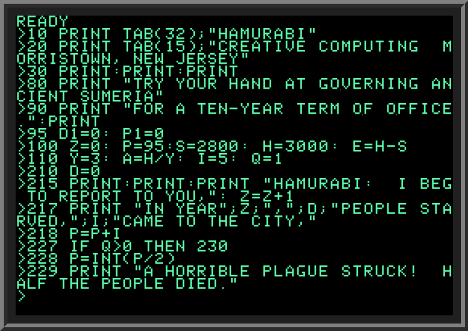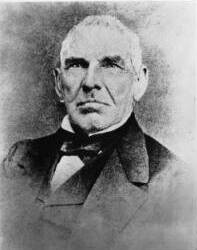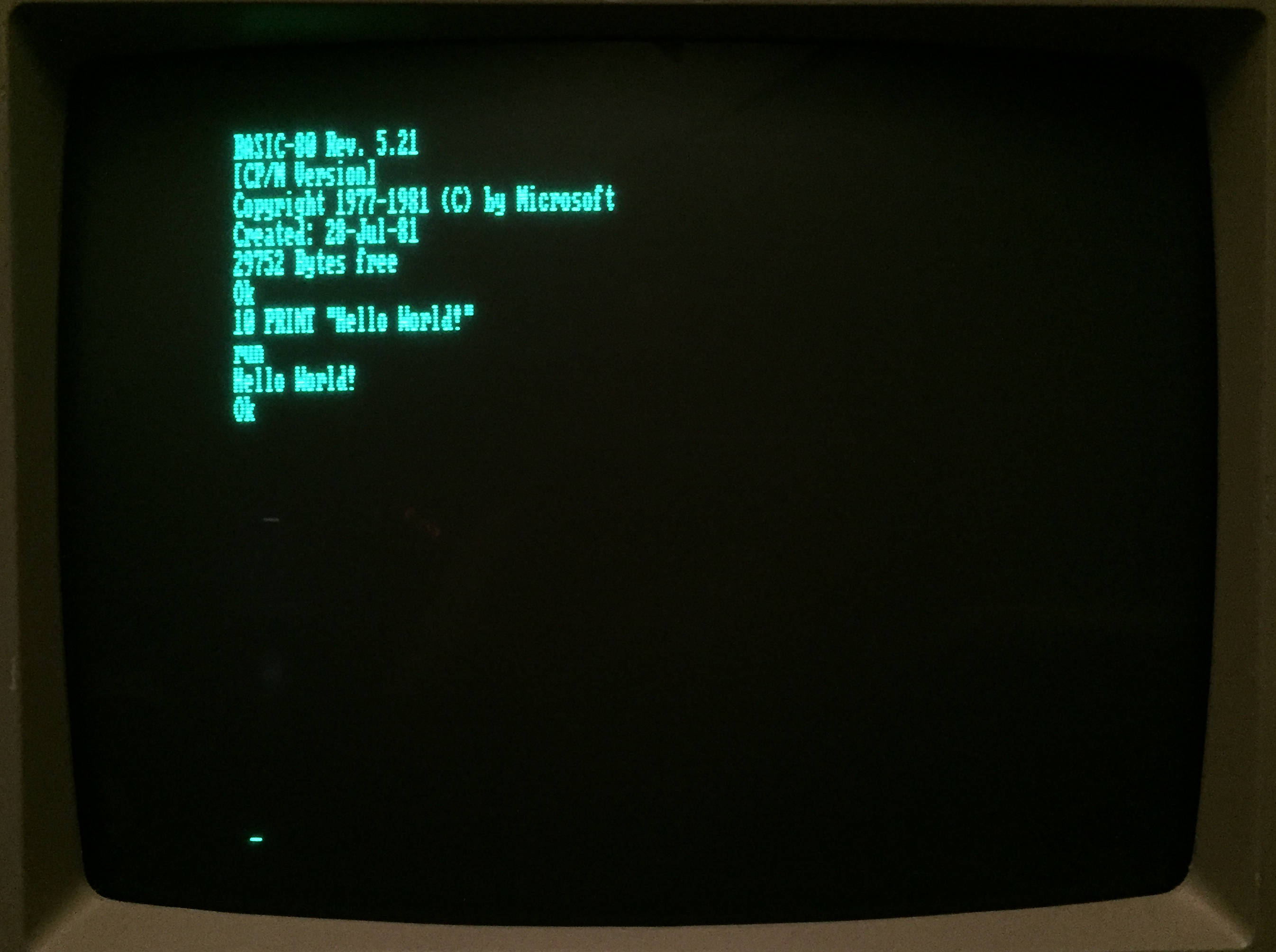|
S-BASIC
S-BASIC (for Structured Basic) was a "structured" BASIC variant, distributed with Kaypro CP/M systems. It was made by Topaz Programming is distributed by Micro-Ap (San Ramon, CA). SBasic was compatible with the syntax of BASIC, a programming language commonly used in the 1970s through the 1980s, as well as Fortran77. However, the language relaxed many of the requirements of BASIC and had more flexibility than Fortran. For instance, line numbers were optional, and permitted non-numeric characters. In addition, SBasic offered developers structured programming concepts, including recursion and nesting. Many PL-1 programs could be compiled with little modification, though SBasic did not offer an extensive function library. Among the more advanced features was the ability to "base" a variable or array, making the memory location dynamic and modifiable during execution. SBasic programs had the ability to access memory areas reserved for the operating system unless prohibited fr ... [...More Info...] [...Related Items...] OR: [Wikipedia] [Google] [Baidu] |
BASIC Interpreter
A BASIC interpreter is an interpreter that enables users to enter and run programs in the BASIC language and was, for the first part of the microcomputer era, the default application that computers would launch. Users were expected to use the BASIC interpreter to type in programs or to load programs from storage (initially cassette tapes then floppy disks). BASIC interpreters are of historical importance. Microsoft's first product for sale was a BASIC interpreter ( Altair BASIC), which paved the way for the company's success. Before Altair BASIC, microcomputers were sold as kits that needed to be programmed in machine code (for instance, the Apple I). During the Altair period, BASIC interpreters were sold separately, becoming the first software sold to individuals rather than to organizations; Apple BASIC was Apple's first software product. After the MITS Altair 8800, microcomputers were expected to ship bundled with BASIC interpreters of their own (e.g., the Apple II, which had ... [...More Info...] [...Related Items...] OR: [Wikipedia] [Google] [Baidu] |
Kaypro
Kaypro Corporation was an American home and personal computer manufacturer based out of San Diego in the 1980s. The company was founded by Non-Linear Systems (NLS) to compete with the popular Osborne 1 portable microcomputer. Kaypro produced a line of rugged, "luggable" CP/M-based computers sold with an extensive software bundle which supplanted its competitors and quickly became one of the top-selling personal computer lines of the early 1980s. Kaypro was exceptionally loyal to its original customer base but slow to adapt to the changing computer market and the advent of IBM PC compatible technology. It faded from the mainstream before the end of the decade and was eventually forced into bankruptcy in 1992. History Kaypro began as Non-Linear Systems, a maker of electronic test equipment, founded in 1952 by Andrew Kay, the inventor of the digital voltmeter. In the 1970s, NLS was an early adopter of microprocessor technology, which enhanced the flexibility of products such as ... [...More Info...] [...Related Items...] OR: [Wikipedia] [Google] [Baidu] |
BASIC
BASIC (Beginners' All-purpose Symbolic Instruction Code) is a family of general-purpose, high-level programming languages designed for ease of use. The original version was created by John G. Kemeny and Thomas E. Kurtz at Dartmouth College in 1963. They wanted to enable students in non-scientific fields to use computers. At the time, nearly all computers required writing custom software, which only scientists and mathematicians tended to learn. In addition to the program language, Kemeny and Kurtz developed the Dartmouth Time Sharing System (DTSS), which allowed multiple users to edit and run BASIC programs simultaneously on remote terminals. This general model became very popular on minicomputer systems like the PDP-11 and Data General Nova in the late 1960s and early 1970s. Hewlett-Packard produced an entire computer line for this method of operation, introducing the HP2000 series in the late 1960s and continuing sales into the 1980s. Many early video games trace their ... [...More Info...] [...Related Items...] OR: [Wikipedia] [Google] [Baidu] |
BASIC Compilers
BASIC (Beginners' All-purpose Symbolic Instruction Code) is a family of general-purpose, high-level programming languages designed for ease of use. The original version was created by John G. Kemeny and Thomas E. Kurtz at Dartmouth College in 1963. They wanted to enable students in non-scientific fields to use computers. At the time, nearly all computers required writing custom software, which only scientists and mathematicians tended to learn. In addition to the program language, Kemeny and Kurtz developed the Dartmouth Time Sharing System (DTSS), which allowed multiple users to edit and run BASIC programs simultaneously on remote terminals. This general model became very popular on minicomputer systems like the PDP-11 and Data General Nova in the late 1960s and early 1970s. Hewlett-Packard produced an entire computer line for this method of operation, introducing the HP2000 series in the late 1960s and continuing sales into the 1980s. Many early video games trace their ... [...More Info...] [...Related Items...] OR: [Wikipedia] [Google] [Baidu] |
CP/M
CP/M, originally standing for Control Program/Monitor and later Control Program for Microcomputers, is a mass-market operating system created in 1974 for Intel 8080/ 85-based microcomputers by Gary Kildall of Digital Research, Inc. Initially confined to single-tasking on 8-bit processors and no more than 64 kilobytes of memory, later versions of CP/M added multi-user variations and were migrated to 16-bit processors. The combination of CP/M and S-100 bus computers became an early standard in the microcomputer industry. This computer platform was widely used in business through the late 1970s and into the mid-1980s. CP/M increased the market size for both hardware and software by greatly reducing the amount of programming required to install an application on a new manufacturer's computer. An important driver of software innovation was the advent of (comparatively) low-cost microcomputers running CP/M, as independent programmers and hackers bought them and shared their crea ... [...More Info...] [...Related Items...] OR: [Wikipedia] [Google] [Baidu] |
Cerritos, California
Cerritos (Spanish for "Little hills") is a city in Los Angeles County, California, United States, and is one of several cities that constitute the Gateway Cities of southeast Los Angeles County. It was incorporated on April 24, 1956. As of 2019, the population was 49,859. It is part of the Los Angeles–Long Beach–Anaheim, California Metropolitan Statistical Area designated by the Office of Management and Budget. History Cerritos was originally inhabited by Native Americans belonging to the Tongva (or "People of the Earth"). The Tongva were called the "Gabrieleños" by the Spanish settlers after the nearby Mission San Gabriel Arcángel. The Tongva were the largest group of indigenous peoples in Southern California as well as the most developed in the region. The Tongva lived off the land, deriving food from the animals or plants that could be gathered, snared or hunted, and grinding acorns as a staple. Beginning in the late 15th century, Spanish explorers arrived in ... [...More Info...] [...Related Items...] OR: [Wikipedia] [Google] [Baidu] |
Jerry Pournelle
Jerry Eugene Pournelle (; August 7, 1933 – September 8, 2017) was an American scientist in the area of operations research and human factors research, a science fiction writer, essayist, journalist, and one of the first bloggers. In the 1960s and early 1970s, he worked in the aerospace industry, but eventually focused on his writing career. In an obituary in ''Gizmodo'', he is described as "a tireless ambassador for the future." Pournelle's hard science fiction writing received multiple awards. In addition to his solo writing, he wrote several novels with collaborators including Larry Niven. Pournelle served a term as President of the Science Fiction and Fantasy Writers of America. Pournelle's journalism focused primarily on the computer industry, astronomy, and space exploration. From the 1970s until the early 1990s, he contributed to the computer magazine ''Byte'', writing from the viewpoint of an intelligent user, with the oft-cited credo, "We do this stuff so you won't ha ... [...More Info...] [...Related Items...] OR: [Wikipedia] [Google] [Baidu] |
MBASIC
MBASIC is the Microsoft BASIC implementation of BASIC for the CP/M operating system. MBASIC is a descendant of the original Altair BASIC interpreters that were among Microsoft's first products. MBASIC was one of the two versions of BASIC bundled with the Osborne 1 computer. The name "MBASIC" is derived from the disk file name MBASIC.COM of the BASIC interpreter. Environment MBASIC version 5 required a CP/M system with at least 28 kB of random access memory (RAM) and at least one diskette drive. Unlike versions of Microsoft BASIC-80 that were customized by home computer manufacturers to use the particular hardware features of the computer, MBASIC relied only on the CP/M operating system calls for all input and output. Only the CP/M console (screen and keyboard), line printer, and disk devices were available. MBASIC in the uncustomized form had no functions for graphics, color, joysticks, mice, serial communications, networking, sound, or even a real-time clock function. MBASI ... [...More Info...] [...Related Items...] OR: [Wikipedia] [Google] [Baidu] |
Hanover, New Hampshire
Hanover is a town located along the Connecticut River in Grafton County, New Hampshire, United States. As of the 2020 census, its population was 11,870. The town is home to the Ivy League university Dartmouth College, the U.S. Army Corps of Engineers Cold Regions Research and Engineering Laboratory, and Hanover High School. The Appalachian Trail crosses the town, connecting with a number of trails and nature preserves. Most of the population resides in the Hanover census-designated place (CDP)—the main village of the town. Located at the junctions of New Hampshire routes 10, 10A, and 120, the Hanover CDP recorded a population of 9,078 people at the 2020 census. The town also contains the smaller villages of Etna and Hanover Center. History Hanover was chartered by Governor Benning Wentworth on July 4, 1761, and in 1765–1766 its first European inhabitants arrived, the majority from Connecticut. Although the surface is uneven, the town developed into an agricultural co ... [...More Info...] [...Related Items...] OR: [Wikipedia] [Google] [Baidu] |
CP/M Software
CP/M, originally standing for Control Program/Monitor and later Control Program for Microcomputers, is a mass-market operating system created in 1974 for Intel 8080/ 85-based microcomputers by Gary Kildall of Digital Research, Inc. Initially confined to single-tasking on 8-bit processors and no more than 64 kilobytes of memory, later versions of CP/M added multi-user variations and were migrated to 16-bit processors. The combination of CP/M and S-100 bus computers became an early standard in the microcomputer industry. This computer platform was widely used in business through the late 1970s and into the mid-1980s. CP/M increased the market size for both hardware and software by greatly reducing the amount of programming required to install an application on a new manufacturer's computer. An important driver of software innovation was the advent of (comparatively) low-cost microcomputers running CP/M, as independent programmers and hacker (hobbyist), hackers bought them and ... [...More Info...] [...Related Items...] OR: [Wikipedia] [Google] [Baidu] |







